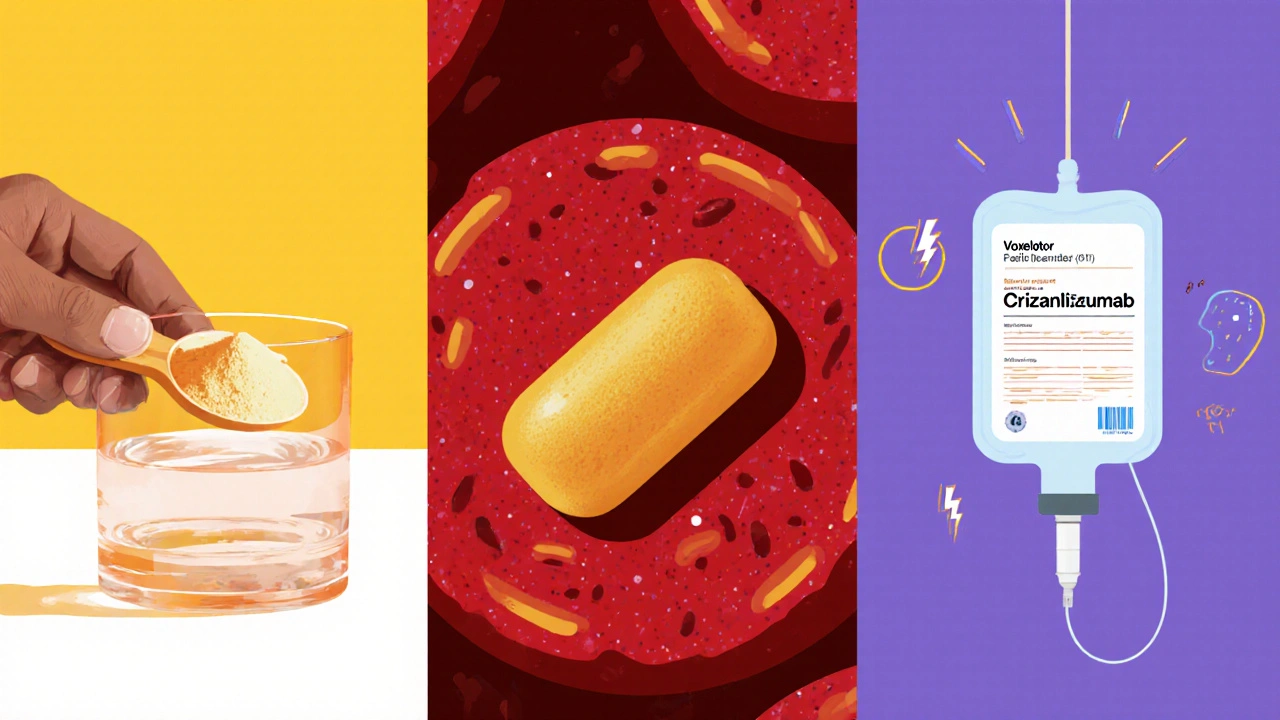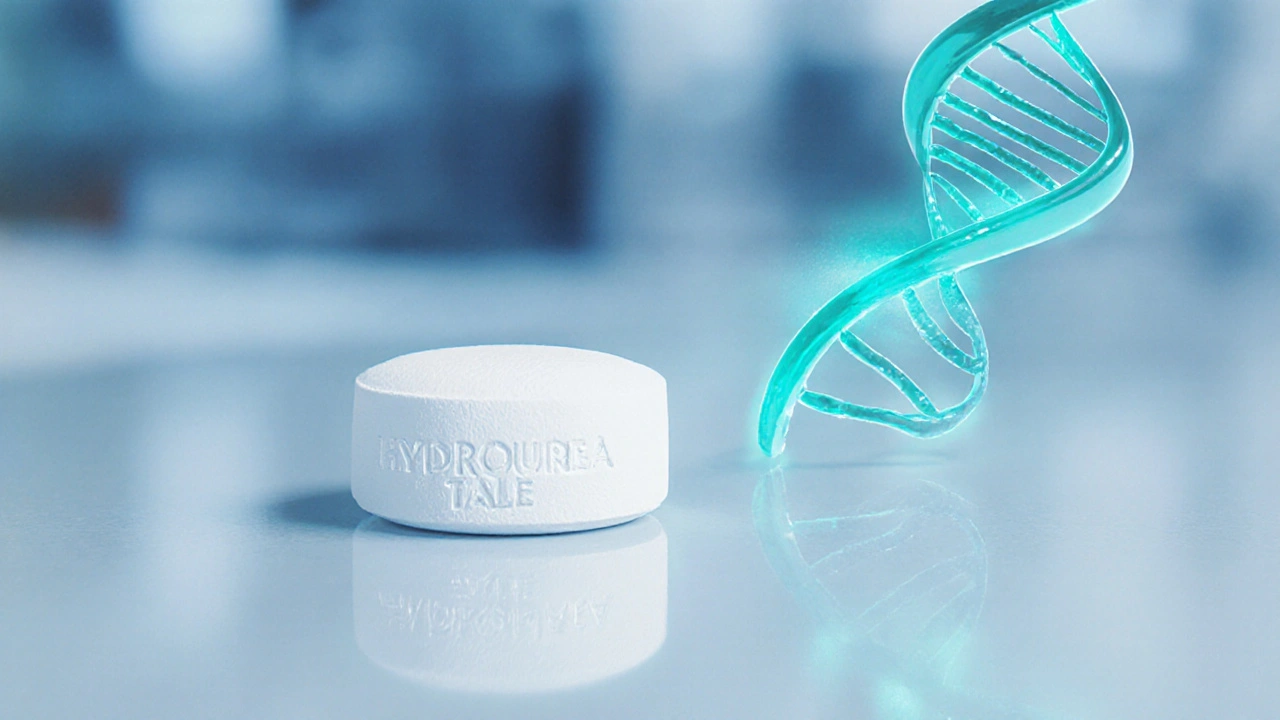Key Takeaways
- Hydroxyurea works by reducing cell proliferation, making it useful for sickle‑cell disease (SCD) and chronic myeloid leukaemia (CML).
- For SCD, newer agents such as L‑glutamine, voxelotor and crizanlizumab target pain crises differently and may have fewer haematologic side‑effects.
- In CML, first‑generation Hydroxyurea is largely replaced by tyrosine‑kinase inhibitors (imatinib, dasatinib, nilotinib) that achieve deeper molecular responses.
- Side‑effect profiles, dosing convenience, and cost vary widely; patients should weigh long‑term safety against short‑term symptom relief.
- A simple decision tree can help you and your clinician match the drug to disease stage, age, comorbidities and insurance coverage.
What Is Hydroxyurea?
When you hear the name Hydroxyurea, think of a small oral tablet that blocks the enzyme ribonucleotide reductase, slowing DNA synthesis in rapidly dividing cells. Hydroxyurea is described as a ribose analog used to reduce the production of abnormal blood cells. First approved in the 1960s, it quickly became a work‑horse for two very different conditions: sickle‑cell disease (SCD) and chronic myeloid leukaemia (CML). Its dual role is rare; most drugs are confined to either oncology or haematology.
How Hydroxyurea Is Used Today
In SCD, the goal is to raise fetal haemoglobin (HbF) levels, which dilute the sickle‑cell polymerisation process. A typical dose starts at 15mg/kg per day and is titrated up to the maximum tolerated amount, often 30-35mg/kg. Monitoring includes complete blood counts every 2-4weeks during dose escalation.
For CML, Hydroxyurea serves as a cytoreductive bridge when a patient cannot immediately start a tyrosine‑kinase inhibitor (TKI). It reduces white‑cell counts quickly but does not target the BCR‑ABL fusion protein, so it never replaces a TKI for long‑term disease control.
Newer Options for Sickle‑Cell Disease
Over the past decade, three agents have earned FDA approval (or equivalent agencies) for SCD and now compete directly with Hydroxyurea.
- L‑glutamine is a naturally occurring amino‑acid that reduces oxidative stress in red cells. The recommended dose is 0.3g/kg twice daily, taken with food.
- Voxelotor binds directly to haemoglobin, stabilising the oxygenated form and preventing polymerisation. The standard dose is 1500mg once daily.
- Crizanlizumab is a monoclonal antibody that blocks P‑selectin, reducing vaso‑occlusive events. It is given as an IV infusion: 5mg/kg at weeks0,2,4, then every 4weeks.
All three have demonstrated a 30-45% drop in annual pain‑crisis rates compared with placebo, but each brings a distinct safety profile.

Current First‑Line Drugs for Chronic Myeloid Leukaemia
Since 2001, the treatment landscape for CML has shifted from non‑specific cytoreduction to targeted therapy. The three most widely used TKIs are:
- Imatinib - a first‑generation inhibitor, 400mg daily, with a 5‑year major molecular response (MMR) rate around 70%.
- Dasatinib - a second‑generation drug, 100mg daily, offering faster deep molecular responses but higher risk of pleural effusion.
- Nilotinib - another second‑generation agent, 300mg twice daily, linked to lower rates of disease progression but can raise serum lipids.
For patients who cannot tolerate any of these, newer agents such as bosutinib or ponatinib are available, but the three listed above cover >90% of prescribed cases in 2024.
Side‑Effect and Safety Comparison
Below is a side‑by‑side look at the most common adverse events for Hydroxyurea and its main alternatives.
| Drug | Typical Side‑Effects | Serious Risks | Monitoring Needed |
|---|---|---|---|
| Hydroxyurea | Neutropenia, thrombocytopenia, mild nausea | Potential teratogenicity, long‑term risk of secondary leukaemia (very low) | CBC every 2-4weeks during titration, then every 3months |
| L‑glutamine | Gastro‑intestinal upset, headache | Rare allergic reactions | Basic metabolic panel annually |
| Voxelotor | Headache, diarrhoea, increased bilirubin | Potential liver enzyme elevation | Liver function tests every 3months |
| Crizanlizumab | Infusion‑related reactions, nausea | Rare severe anaphylaxis | Vital signs during infusion; CBC monthly for first 6months |
For CML, the safety matrix shifts toward cardiovascular and pulmonary considerations.
| Drug | Common Adverse Events | Key Serious Concerns | Monitoring Frequency |
|---|---|---|---|
| Imatinib | Edema, muscle cramps, nausea | Hepatotoxicity, cardiac failure (rare) | Liver enzymes every 3months; CBC every 3months |
| Dasatinib | Fluid retention, rash, diarrhea | Pleural effusion, pulmonary arterial hypertension | Chest X‑ray every 6months if symptoms arise |
| Nilotinib | Myalgia, headache, rash | QT‑prolongation, hyperglycaemia, dyslipidaemia | ECG and fasting lipids at baseline and every 6months |
| Hydroxyurea | Bone‑marrow suppression, gastrointestinal upset | Teratogenicity, rare secondary malignancies | Complete blood count weekly during initiation, then monthly |
Cost and Accessibility
Affordability often decides which drug a patient can stay on. Average wholesale prices (2024 US data) are:
- Hydroxyurea - $0.10 per 500mg tablet (≈$30/month for a typical SCD dose)
- L‑glutamine - $1.50 per 3‑g sachet (≈$180/month)
- Voxelotor - $50 per 500mg tablet (≈$1,500/month)
- Crizanlizumab - $2,500 per infusion (≈$10,000/year)
- Imatinib - $40 per 400mg tablet (≈$1,200/month)
- Dasatinib - $60 per 100mg tablet (≈$1,800/month)
- Nilotinib - $70 per 300mg tablet (≈$2,100/month)
Many national health services (including Australia’s PBS) subsidise Hydroxyurea heavily, whereas newer biologics often require special authorisation or private insurance coverage. Patients should check local formularies before committing.
Choosing the Right Option - A Simple Decision Tree
- Identify the disease focus. Sickle‑cell disease or CML?
- Assess disease severity. Frequent pain crises, high white‑cell count, or early‑phase leukaemia?
- Review comorbidities. Pregnancy, liver disease, cardiac risk, or renal impairment?
- Check insurance or government coverage. Is the drug on the subsidised list?
- Match drug profile.
- For SCD with mild‑to‑moderate crises and no pregnancy concerns, Hydroxyurea remains first‑line because of cost and proven HbF boost.
- If Hydroxyurea causes severe neutropenia, consider L‑glutamine (oral, low‑cost) or Voxelotor (oral, higher cost but less marrow suppression).
- For patients with recurrent vaso‑occlusive events despite Hydroxyurea, add Crizanlizumab as an adjunct.
- In CML newly diagnosed and without contraindications, start a TKI (Imatinib → Dasatinib/Nilotinib based on risk of cardiovascular disease).
- If a patient cannot tolerate any TKI, a short bridge with Hydroxyurea may be used while assessing alternative dosing regimens.
- Monitor and adjust. Follow the lab‑testing schedule outlined above; switch only after documented inadequate response or unacceptable toxicity.
Practical Tips for Patients and Clinicians
- Keep a symptom diary - pain‐crisis frequency, severity, and any medication side‑effects.
- Never stop Hydroxyurea abruptly without a doctor’s plan; sudden withdrawal can raise crisis rates.
- For oral agents, take with food to minimise GI upset; for injectable Crizanlizumab, pre‑medicate with antihistamine if you’ve had prior reactions.
- Ask your pharmacist about patient‑access programs; many manufacturers offer free‑trial doses for newer drugs.
- Regularly review your insurance coverage; drugs that were costly two years ago may now be listed as generics.
Frequently Asked Questions
Can Hydroxyurea be used during pregnancy?
Hydroxyurea is classified as a Category D drug - it may cause fetal harm. Women of child‑bearing age should use effective contraception and discuss alternative therapies with their hematologist if they become pregnant.
How quickly does Hydroxyurea raise fetal haemoglobin?
Most patients see a measurable HbF increase within 8-12weeks of reaching a stable dose. Maximum benefit often appears after 6months of consistent therapy.
Is Crizanlizumab a replacement for Hydroxyurea?
No. Crizanlizumab is approved for patients who continue to have ≥2 pain crises per year despite being on Hydroxyurea. It is usually added on, not swapped.
Why would a doctor still prescribe Hydroxyurea for CML today?
Hydroxyurea may be used as a temporary measure when a patient cannot immediately start a TKI due to drug interactions, severe organ dysfunction, or pending insurance approval. It quickly lowers white‑cell counts while the definitive therapy is arranged.
Which drug has the best long‑term survival data for CML?
Second‑generation TKIs (dasatinib, nilotinib) consistently achieve deeper molecular responses and lower progression rates than imatinib, translating into superior 10‑year survival (>95%). Hydroxyurea does not provide these long‑term benefits.

Edward Glasscote
October 14, 2025 AT 21:28Hydroxyurea is cheap and works for many SCD patients.
Gaurav Joshi
October 24, 2025 AT 13:28Everyone hypes the new pricey drugs while ignoring the fact that Hydroxyurea’s side‑effects are overblown. The cost difference alone makes the older therapy the smarter pick. New agents also add infusion hassle that most patients can’t afford.
Jennifer Castaneda
November 3, 2025 AT 04:28Hydroxyurea has been on the market since the 1960s, yet its reputation is still clouded by misinformation propagated by pharmaceutical interests. The drug’s mechanism of inhibiting ribonucleotide reductase is straightforward, and its capacity to elevate fetal hemoglobin is well documented in peer‑reviewed studies. What is less discussed is the extensive lobbying that accompanies the promotion of newer agents such as voxelotor and crizanlizumab. These companies invest heavily in marketing campaigns that portray their products as universally superior, regardless of comparative cost‑effectiveness analyses. Independent health economists have repeatedly shown that the incremental quality‑adjusted life‑year gains from these biologics are marginal when hydroxyurea is properly titrated. Moreover, the long‑term safety data for the newer monoclonal antibodies remain limited, raising concerns about unforeseen immune reactions. It is also worth noting that the regulatory approval processes for these drugs often rely on surrogate endpoints rather than hard mortality outcomes. Patients who are correctly screened for contraindications can safely continue hydroxyurea without the need for expensive infusion centers. The risk of secondary malignancies associated with hydroxyurea is statistically insignificant when compared to the baseline cancer risk in the general population. In contrast, the liver function abnormalities observed with voxelotor require regular monitoring that increases the overall burden of care. The alleged teratogenicity of hydroxyurea has been exaggerated; recent registry data indicate that pregnancy outcomes are comparable to those of untreated SCD patients when appropriate contraception is used. Insurance providers are aware of these nuances, and many prefer to authorize hydroxyurea as first‑line therapy to control expenditures. When clinicians deviate from this practice, they often do so under pressure from pharmaceutical representatives rather than patient‑centered evidence. Therefore, a balanced discussion with patients should include transparent information about both efficacy and financial implications. Ultimately, the decision should rest on individualized risk–benefit assessment, not on marketing hype.
Annie Eun
November 12, 2025 AT 20:28Picture this: a patient battling daily pain crises, clutching a bottle of cheap Hydroxyurea while the clinic offers a gleaming infusion of crizanlizumab. The drama unfolds when insurance denies the infusion and the patient is left with a choice between comfort and cost. Hydroxyurea may not be glamorous, but its proven track record is a steady drumbeat against the chaos of newer therapies. The irony is palpable when a high‑tech drug promises relief yet delivers only a handful of extra days free from pain. Yet the heart of the matter remains simple-stability, accessibility, and a medication you can take at home. In the end, the hero’s journey is often just a small tablet that keeps the blood flowing.
Jay Kay
November 22, 2025 AT 12:28Hydroxyurea works by raising fetal hemoglobin levels and lowering white cell counts has a simple dosing schedule and cheap price point makes it a practical first line option for many patients
Mike Creighton
December 2, 2025 AT 04:28In the grand tapestry of medicine, each drug is a thread woven into the fabric of human hope. Hydroxyurea, humble yet resilient, reminds us that simplicity can coexist with profound impact. When we chase the newest miracle, we risk unraveling the very stability our patients cherish. Let us honor the quiet power of the old alongside the allure of the new.
Desiree Young
December 11, 2025 AT 20:28I think the cost analysis in this post is off Hydroxyurea is way cheaper and just as effective dont let big pharma fool you